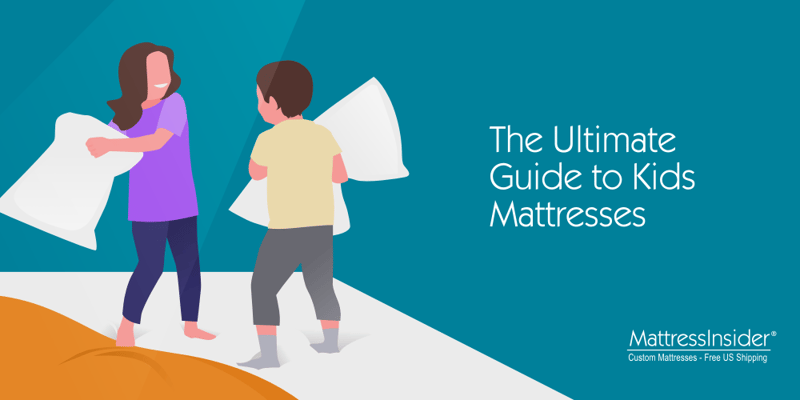If you know the importance of a good night’s sleep, you know how vital it’s to get your child the right mattress. In this ultimate guide to kids’ mattresses, we take a deep dive into how to choose a mattress for a child.
As you will see, the right mattress offers the correct type of support, comfort, and durability. Choosing the right mattress for your child also means keeping size in mind. After all, you’d want a mattress size that will grow with your child.
Ready to learn how to choose a kids’ mattress? Read on!
How to Choose a Kids’ Mattress
Being a parent means making many small and big decisions – all the time. The type of mattress a child sleeps on is one of the big decisions. The right mattress helps your child get a good night’s sleep so their body and brain can repair and rebuild.
Studies show that poor sleep leads to a host of problems, including fatigue, memory problems, mood changes, lack of concentration, high blood pressure, and even childhood obesity.
If you’re unsure how to choose a kids’ mattress, keep a few important factors in mind. For instance, material, firmness, edge support, and stage of life all play a role in determining the right mattress for your child.
Here are things you should consider when choosing a kids’ mattress.
1. Choose the Correct Size
There are a few factors to consider when choosing the right size mattress for your child. These include age, how big/small your child is, and the bedframe size. You should also ask yourself how long you want the mattress to last.
For a toddler, you’d choose a standard crib mattress. But what about older kids? For older kids, the standard mattress sizes are twin, twin XL, and full.
The mattress size you choose depends on the room size, bedframe, your child’s size and age, and their sleeping habits. For example, if you know your 8-year-old moves around a lot during sleep, a full-size mattress may be a better fit, versus a twin.
In most cases, the bigger the mattress, the better. This is because your child can grow with the mattress instead of having to buy a new one every few years. Not only does this save you money, but it also spares your child the unnecessary trouble of trying to get used to a new mattress.
2. Assess the Materials of the Mattress
When choosing the right mattress for your child, it’s also important to consider the materials used in the mattress. Many mattresses use synthetic materials, and the chemicals used in these materials can either worsen a child’s allergies or trigger them.
Consider natural materials if you have a child with respiratory problems or other allergies. Mattresses with natural materials such as organic wool, bamboo, natural latex, and cotton prevent possible reactions.
Another great feature of mattresses made of organic or natural materials is that bacteria don’t grow on them. Whether your child has health issues or not, choosing a mattress with natural materials is one of the best decisions you can make.
This will ensure that your child sleeps peacefully while protecting them from harmful chemicals that conventional mattresses release, especially since body heat can trigger the release of toxic chemicals found in these mattresses.
3. Select the Right Type of Support
While many things make a good mattress, it’s fair to say that proper support is one of the most important features to look for. The right support reduces pressure, helps maintain spinal alignment, and evenly distributes body weight. Here are different types of mattress support:
Memory foam mattresses: This mattress type is made of high-density foam that provides extra cushioning and support. Memory foam mattresses allow your child to “sink” into the mattress and feel cradled. This mattress type also offers good spine alignment and overall support.
Innerspring: Made usually of steel coils that compress when weight is placed on them, innerspring mattresses provide a coil support system. The primary purpose of innerspring mattresses is to provide, you guessed it, support.
More coils generally mean higher quality and more support. Unlike foam mattresses, innerspring mattresses offer targeted support and structure. While innerspring mattresses are popular, they tend to wear out faster than other mattresses.
But that doesn’t mean they’re a bad choice for kids. On the contrary! Since children aren’t heavy enough to cause stress to the coils, innerspring mattresses can last longer.
Latex mattresses: Though not as popular as the other types, latex mattresses provide excellent support. Unless they’re hybrid mattresses, latex mattresses don’t have innerspring coils.
The more dense layer of latex conforms to your body and provides support regardless of sleep position. This kind of support is important for children as it allows for pressure relief as they sleep. Latex mattresses generally sleep cooler and are made of natural materials.
4. Pick the Level of Comfort
It’s fair to say that comfort plays a big role in determining how well your child sleeps. When choosing a mattress for a child, consider comfort level like other areas.
Finding the right comfort level depends on what kind of sleeper your child is. Since this depends on the firmness level of the mattress, here are the recommended ranges for those who weigh under 130 lbs:
Side sleepers: If your child is a side sleeper, a soft mattress in the range of Soft (2) to Medium Soft (4) is a good choice.
Stomach sleepers: As a stomach sleeper, a mattress in the range of Soft (3) to Medium Soft (4) can provide the comfort level they need.
Back sleepers: Generally speaking, back sleepers require a mattress on the firmer side. This is particularly important as a mattress that’s firm (or too soft) can put pressure on the lower back. This is why back sleepers prefer a mattress in the range of Soft (3) to Medium (5).
Combo sleepers: If your child is a combination sleeper, a mattress in the range of Soft (3) to Medium Soft (4) is recommended. As a general rule, moderate firmness level works best for combo sleepers, including your little/big one!
5. Decide on a Durable Design
When choosing a mattress for a child, consider how durable the design is. You’d want to choose a durable mattress, so you don’t have to buy a new one every year or two years.
The right mattress is made of high quality and holds both its shape and support over the years. The mattress materials are important to consider as they determine how long they will last.
More importantly, the materials also determine what kind of abuse a mattress can withstand. We all know how accident-prone children are!
The usual lifespan of a mattress is 7-10 years. But some mattresses, such as latex mattresses, last 15 years. Of course, the higher the quality of a mattress, the higher the price tag.
6. Consider the Foundation
Now that you’ve chosen the right mattress for your child, you think you can sit back and relax. Not so fast! While the right mattress for kids is important, you must also consider the foundation.
A foundation, also known as a base, is a metal or wooden frame with a sturdy, flat board that sits under a mattress. Its role is to provide strong support and protect the mattress from wear.
Most foundations are compatible with almost all mattresses out there. So it would be easy for you to find the right foundation for the mattress you’ve chosen for your child.
Another option as a base is box springs. These are made of wooden frames, have a layer of steel coils, and are covered in fabric. This type of base is ideal for mattresses with springs.
The coils in box springs reduce pressure, absorb shock, and promote airflow, which is important for breathability.
A foundation and a box spring support a mattress and influence comfort level. The base you choose depends on the mattress you want and the support and comfort level you’re looking for.
What are the best mattresses for kids?
If you’re looking for the best mattresses for kids, know that there are a few things you should consider. Every child is different, and the mattress you choose will depend on your child’s sleep position, age, and size.
The best mattress for children is one that provides the proper support, is durable, has the right comfort level, and is made of natural materials.
Where can I purchase a mattress for kids?
You won’t be disappointed if you’re after high-quality mattresses for children. Companies like 5 Little Monkeys specialize in children’s mattresses. But the top mattress companies also sell children’s mattresses, so you can rest assured you’re getting the best for your child. These include the following:
- Helix
- DreamCloud
- Saatva
- Nectar
- Nolah
- Brooklyn Bedding
- Leesa
How much does a kid's mattress cost?
How much your child’s mattress will cost will depend on the type of mattress, its features, size, and quality. Generally speaking, a kid’s mattress can cost between $274 – $1,799.
To give you an example using one of the companies mentioned above, the Brooklyn Bedding Chill mattress ranges between $274 – $699 depending on size. This would be on the cheaper side.
For middle-range pricing, the DreamCloud Mattress ranges between $699 – $1,299. If money is no object, there’s the Nolah Nurture 10 mattress, which costs between $1,499 – $1,799.


